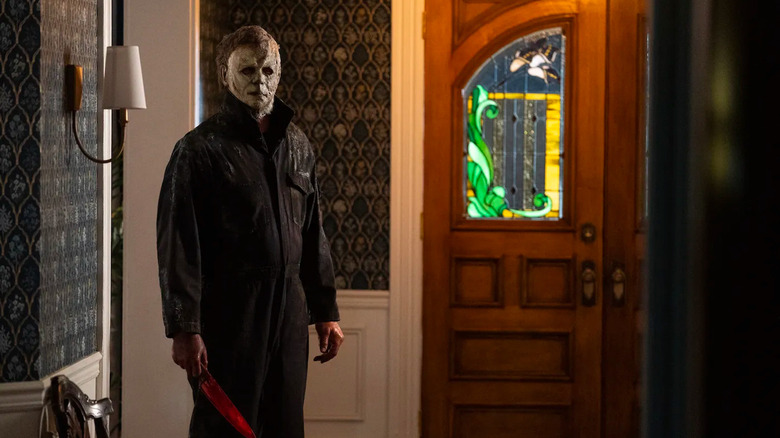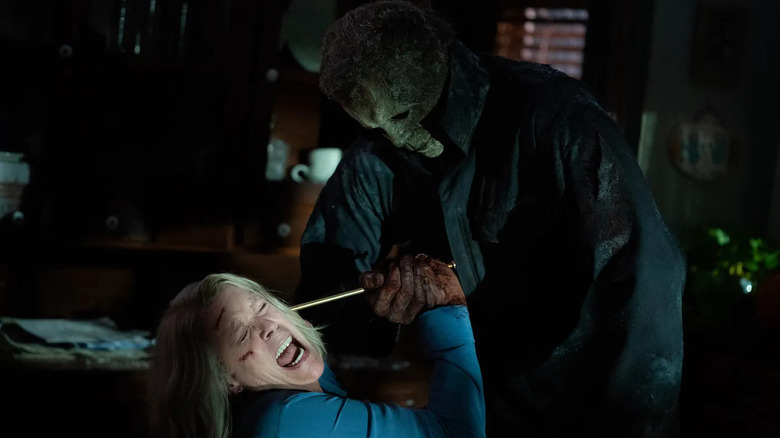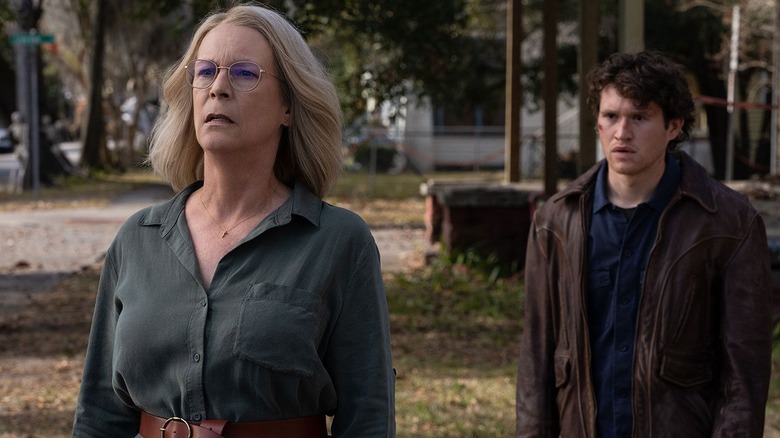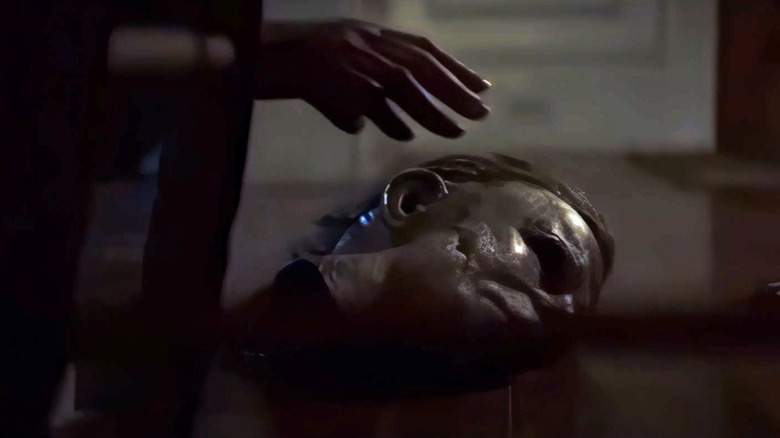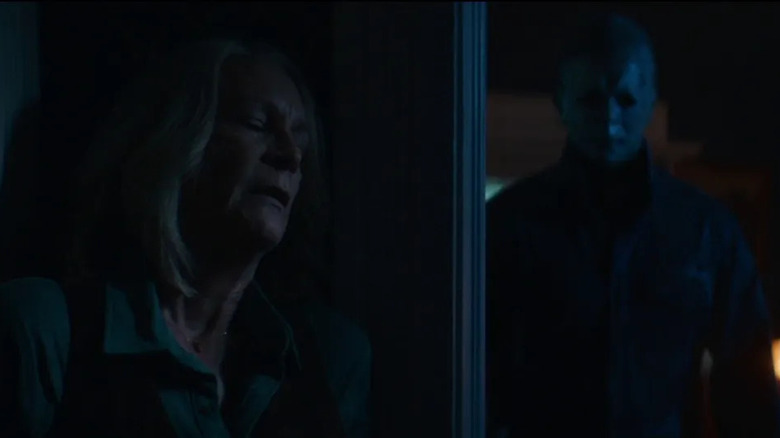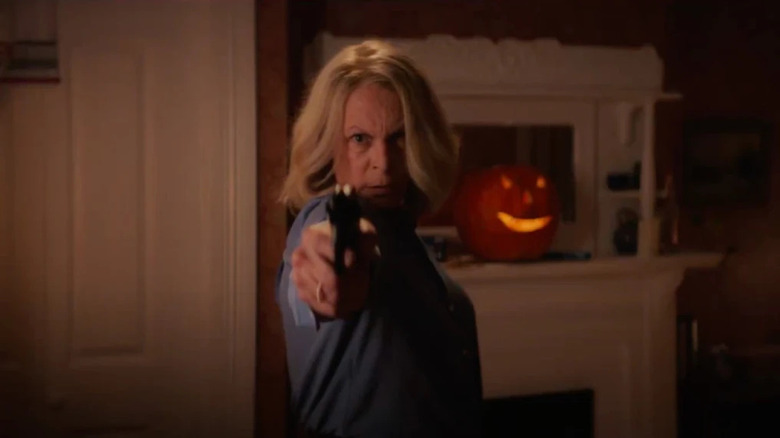Halloween Ends Ending Explained: Evil Changes Shape
Partway through John Carpenter's original "Halloween," Dr. Sam Loomis (Donald Pleasance) is looking for Judith Myers' grave when a Graveyard Keeper (Arthur Malet) relays to the doctor the story of one Charlie Bowles, a man who used to live in a nearby town with a wife and two children until one day when old Charlie "went out to the garage and got himself a hacksaw" before going back into his house and greeting his family. Neither Dr. Loomis nor we the audience get to hear exactly what Charlie did next, but we can infer quite a bit.
Especially as "Halloween" is the story of one Michael Myers, a Haddonfield resident who, as a young boy of six, brutally murdered his sister on October 31st of 1963. Like Charlie, Michael's actions were similarly unexpected and unprovoked, leading Loomis to conclude that Myers was "purely and simply ... evil." Carpenter insisted that the adult Myers be referred to as "The Shape," a thing that used to be human but was no longer.
In addition to the Charlie Bowles story, there's another moment in "Halloween" toward the end of the film that's easily overlooked: Laurie Strode (Jamie Lee Curtis), a girl desperate for a cute boy to notice her, gets what she wished for in the worst way as Michael attacks her wearing a blank, featureless mask. During their struggle, Laurie pulls Michael's mask off, revealing a cute boy of 23 years old (Tony Moran). The boy looks scared, haunted even, as if he doesn't understand what's happening and what he's doing.
"Halloween Ends," the final chapter in the sequel trilogy by director David Gordon Green, extrapolates and explores those two moments from Carpenter's film, using them as a thesis to tie up the concepts raised by both 2018's "Halloween" and 2021's "Halloween Kills" as well as the franchise as a whole. It's a look at the nature of Evil itself, a force that cannot be understood or explained but is a thing that everyone must reckon with.
Don't let it get infected
Throughout Green's sequel trilogy, it's been difficult for audiences and critics to grasp exactly what he and his cast and crew were attempting to do with the "Halloween" mythos. Where the 2018 "Halloween" was touted as a return to form, there were too many oddities about it that kept it separate and unique from Carpenter and Debra Hill's lean, mean Swiss watch of a slasher. Those oddities became multiplied with "Halloween Kills," a sequel that many fans of the 2018 film vehemently disliked as it leaned harder into the theme of Evil as a virulent and destructive force.
"Halloween Ends" puts the sequel trilogy into clear perspective: these films haven't been a mere retread or dull tribute to Carpenter's original, but an examination on the part of Green, his co-writers (Paul Brad Logan, Chris Bernier and Danny McBride) and the rest of his team of the trauma Evil can inflict and the cyclical way it perpetuates itself.
Green and company even deliberately lean into current events that have transpired since 2018. Since both "Halloween" and "Halloween Kills" were set on the same night in '18 (despite "Kills" being released in '21), the films haven't addressed the Covid pandemic, obliquely or otherwise. But it was certainly on Green's mind when making "Ends," as this interview from last year proves.
"Kills" doesn't do something as hackneyed as having the citizens of Haddonfield get vaccines against Evil or the like; rather, it establishes Michael Myers as a mythic Patient Zero of Evil, something that seems like it would've been the case whether the real-life pandemic happened or not. Myers' Evil is something that everyone in Haddonfield has been exposed to, and whether or not it takes hold is up to them.
The babysitter (does) murders
"Halloween Ends" begins by introducing its major new character, Corey Cunningham (Rohan Campbell) in 2019, one year after Myers resurfaced and then disappeared into the night. Having been hired by a married couple to watch their young son during Halloween night, Corey is verbally abused by the child before being tricked into entering the attic of the home and subsequently locked in. Attempting to escape, Corey kicks open the attic door, hitting the child hard enough to topple him over the ledge and down onto the floor several stories below.
In present-day 2022, Corey has long since been legally cleared of wrongdoing, but most of Haddonfield (including the child's mother) consider him a filthy murderer. Unlike Michael Myers, Corey has ample reason to snap into psychopathy: the months of being a social pariah combined with physical bullying at the hands of a local gang of teens and his own abusive mother seems like a perfect recipe for murder.
Laurie Strode recognizes this, and does her best to draw Corey back to the light by encouraging a relationship to blossom between him and her granddaughter Allyson (Andi Matichak). A spark does indeed occur between them, but unfortunately, Allyson is unknowingly drawn to the darkness inside Corey as he begins to spiral. The ultimate catalyst is when Corey stumbles upon a still (barely) living Michael, who has been lurking beneath Haddonfield like a rat infected with plague. Michael senses the Evil inside Corey and sparks it to life. Thus, Corey becomes a sort of Sorcerer's Apprentice to Myers, letting the boogeyman loose while feeling free to commit atrocities of his own.
The virus spreads
As a character in "Ends" wonders aloud, was the Evil inside Corey always there, or was it put there? That's been the central question regarding Michael Myers since that night in 1963, and Green does not attempt to answer it. However, "Ends" and his prior "Halloween" films examine the effects of Evil and the parallel moments that occur as a result.
To wit, numerous characters find themselves indirectly responsible for murder: Officer Hawkins (Will Patton) back in 1978, the citizens of Haddonfield in 2018 (who drove Lance Tovoli to his death in "Kills"), Corey Cunningham, and Laurie Strode herself, who is reminded several times during "Ends" that her actions in 2018 stirred up the force that is Michael Myers, resulting in a string of violent deaths.
These people have all been exposed to a strain of Evil, but only Myers, Dr. Sartain (in 2018) and Corey contracted the virus. Dr. Sartain's infection was distinct from Myers', just as Corey's is. In Corey's case, he seeks revenge on those who've abused or mistreated him, eventually extrapolating that to anyone who stands in the way of what he wants. He wants Allyson, and after convincing her to leave Haddonfield with him on Halloween night, he stalks Laurie, having been warned by her to stay away from Allyson.
Wearing Michael's stolen mask, Corey attacks Laurie only to be shot by her. She makes a final attempt to appeal to his better nature. Still, the human Corey is gone — the Shape that remains decides to stab himself in the throat, killing himself so that Allyson will see her grandmother standing over his dead body, and draw the conclusion that Laurie killed him.
It's time to cut out the cancer
In mythical terms, if Allyson has taken Laurie's role from 1978 and Corey has taken Michael's, then Laurie has become Dr. Loomis: resilient, watchful, wise (Laurie is hard at work on her memoirs, which almost seem like a more poetic and philosophical version of Loomis' psychiatric notes) and able to sense pure Evil. After Corey is dead, the source of Evil returns and Michael and Laurie have their final confrontation. Michael almost emerges victorious, but Allyson, having come out from under Corey's hold, helps her grandmother deal a series of fatal blows to Myers.
This isn't the "ah, he must be dead now" attempt of the original film nor the subsequent "who could even survive that?" assumptions of many other "Halloween" conclusions (including 2018's) or even the cathartic victory of "H20." Laurie, having taken over Loomis' role, is far more clinical, methodical, and thorough about doing away with Michael this time. She and Allyson slice open all his major arteries, letting him bleed out completely before bringing his lifeless corpse outside and tying it to a police vehicle.
With Hawkins' full support, Laurie, Allyson and the citizens of Haddonfield take Michael on a funeral procession to the body shop where Corey once worked and toss his corpse into a huge metal grinder, leaving only mashed-up pieces of the killer behind. Clearly, no magic quirk of circumstance or otherwise can bring Michael back to life. As Loomis once said, "the evil is gone."
Evil never dies, but life goes on
Some are already comparing "Ends" to "Friday the 13th Part V: A New Beginning," in which the Evil that Jason Voorhees represents appears to transfer over to one of his victims. Yet one needn't venture outside the "Halloween" franchise to find a precedent for the ideas "Ends" explores: the idea found in most of the sequels, that Michael was secretly Laurie's brother, continually brought up the notion of Evil as a hereditary condition, a congenital or mental illness. It possessed Jamie Lloyd (Danielle Harris) for a short time in "Halloween 4," became a Cult in "Halloween: The Curse of Michael Myers" and found its way into Scout Taylor-Compton's Laurie Strode at the close of Rob Zombie's "Halloween II."
This long history of the "Halloween" films exploring the same themes and topics illustrates the way David Gordon Green and company made a sequel trilogy that continues the franchise and its traditions while carving its own path and commenting on the series itself. Myers' continual return to wreak havoc on innocent victims is partly the audience's doing, after all, and Green doesn't condemn that so much as explore how our need to tell such stories speaks to a need to reckon with Evil within our species and culture. The series is entitled "Halloween" for more than one reason — it's a holiday that has origins involving human beings needing to acknowledge the darkness inside themselves.
Yet it's also just one day and night, and it must come to an end eventually. "Halloween Ends" provides that closure, as the town of Haddonfield finds some temporary peace with their boogeyman unequivocally destroyed, Allyson gets to move on and find her own destiny, and Laurie rekindles the spark she once had with Hawkins, her life flush with promise where it was once closed off by trauma and fear. As the film's closing still images of spaces we've seen before, now infused with bright daylight, recall the ominous ending of "Halloween '78," it's a reminder that Halloween will come back again next year, undoubtedly wearing a new face and in a new Shape; another reboot, another remake, what have you. For now, however, Evil is shapeless, Laurie has not only survived but become victorious, and "Halloween" is over.
